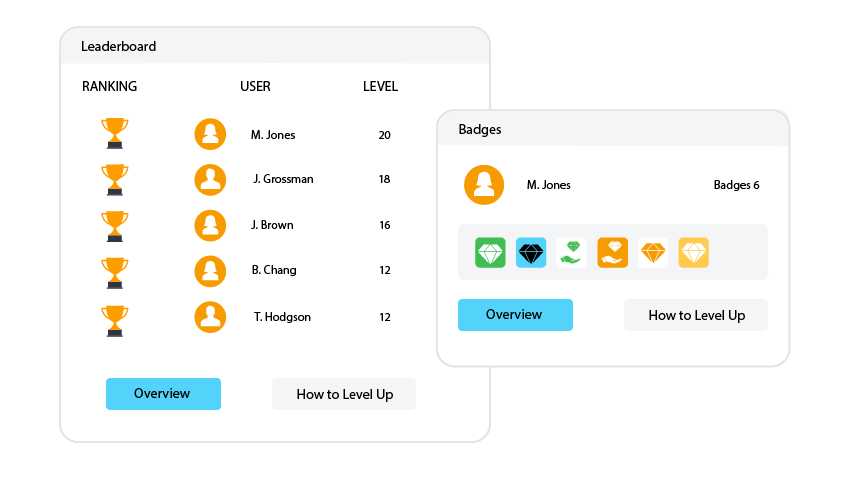A corporate (or employee) trainer holds a powerful and influential role in any company. They’re responsible for inspiring and nurturing a workforce that’s one step ahead when it comes to business objectives. Their remit can span everything from onboarding to ongoing development. And their sphere of influence is heavily linked to employee engagement and retention. In short, an organization’s got a lot to thank them for.
But many corporate trainers don’t have a training (or HR) background. In some cases, they’re high-flying employees who may not have actively sought the role. Rather they’ve been absorbed into the position to meet an emerging and often unplanned-for business need. Or, conversely, they’re employees who are interested in training and have proactively sought a sideways move to forge a new and fruitful career in learning and development
Stepping into an unfamiliar environment means learning on the job. And getting up-to-speed, fast. Self-starters with ambition, corporate trainers without formal qualifications are quick to master the basics, organizing and even delivering training to a potentially vast and diverse workforce.
But, despite having the confidence and the motivation, many corporate trainers (particularly those without formal training) are left asking the questions: How am I doing? And… What’s next?
In this guide, we help corporate or employee trainers (you?) evaluate their role and their effectiveness. We provide tactics for improving the outcomes and delivery of day-to-day tasks. And offer tips on how to make a career in training.
Building better courses: Your questions answered
Powered by an LMS with a built-in content authoring tool, as an employee trainer, you will likely have established good routines when it comes to designing courses. You’re probably already re-using existing material across different modules, importing content from the web, and sourcing ready-made courses using content libraries.
Despite this, our research reveals a series of pain points experienced by training professionals looking to develop a specialist career in learning and development. And most of them relate to moving from design courses to designing great courses.
Let’s take a look at some of the most common questions L&D professionals have. And see how they relate to that one big overarching question: How to become a training and development specialist?
How can I better curate content?
Organizing and storing content so it’s available to learners when they need it encourages a culture of continuous learning. And it’s essential for nurturing an effective training career. But it requires a strategy to ensure learning resources are relevant, up-to-date, and enriched on an ongoing basis.
To do this, it’s important to:
- Set up forums to obtain feedback and inputs from learners and subject matter experts
- Create communities of practice
- Establish a filing system for resources based around meaningful and intuitive classifications
- Begin with areas of training that link directly to a clear ROI
- Form a team of people responsible for keeping content accurate, appropriate, and timely
- Regularly review and revise the original strategy taking into account subsequent feedback, analytics, and reports around patterns of use
- Ensure learning resources are available on multiple devices, especially mobile
- Publicize and promote curated content
- Ask users to share “success stories” to build momentum around usage
Build unique training content with an easy-to-use editor
Design online courses in just a few clicks with TalentLMS.
The training platform that users consistently rank #1.
How do I know that what I’ve found online is good enough to include in a course?
The go-to tool for research, Google is a limitless pool of knowledge. But it’s not exclusively so.
In fact, it houses as many inaccuracies as it does informed insights. There’s an art to first finding the information you want, and then knowing if you can trust what you’ve found. And it’s this art that provides one answer to the question: ‘What does a training and development specialist do?’
When using the internet to source content for training programs, try the following advanced search skills to fine-tune your searching strategy:
- Use Boolean operators and symbols such as “AND,” “OR,” and “NOT” to produce more targeted and relevant results. Add quotation marks to search for a specific keyword. And use the minus sign to eliminate evidence of a previous search term.
- Scan the footer for the last date the page was updated.
- Analyze the domain name to put the content in context. For example, established institutions are often more reliable. These include educational (.edu), governmental (.gov), or nonprofit (.org) organizations. These can (but not always) be more reliable. Commercial sites (using the suffix “.com”), such as reputable news organizations or high-ranking industry-leading service providers, can also be good sources, but may warrant extra investigation to confirm reliability.
- Be specific. Look for websites that specialize in the kind of information you’re seeking.
- Research the author. What are their credentials? Avoid content that isn’t attributed.
- Look for links that back up opinions with independent research.
- Verify information by cross-checking against other reputable sources.
- Assess the look of a page. Is it well-designed? Is the content well-written?
- Check the links on the page. Reputable websites usually link to each other.
*Tip: Copy “link:http://www.[WEBSITE].com” into Google, replacing “[WEBSITE]” with the domain of the site you’re researching to see what websites it’s linking to.

How do I work with subject matter experts (SMEs)?
Lots of training programs benefit from SMEs who apply deep technical knowledge to a particular topic. But the truth is, while they’re experts in a particular field, they’re not necessarily experts in training. Neither will they have ‘Subject Matter Expert’ as their official job title.
So, how do you find an SME? And, more importantly, how do you make sure their knowledge is optimized?
A key aspect of a successful training career, let’s dig deeper into the skills surrounding SME sourcing and input.
How to find SMEs:
- Activate a referral scheme. Recommendations are a great way to find SMEs because they already come with an element of credibility.
- Look internally. Most organizations have employees who’ve achieved higher levels of experience and accreditations in a particular field.
- Go online. LinkedIn, professional associations, other social networks, and specialist industry forums are good ways to find experts with specific areas of interest.
How to work with SMEs:
- Use training intake forms to structure SME input and apply instructional design eye to content suggestions.
- Clarify from the start what specific topics your SME plans to cover and identify any gaps in provision.
- Assess your SME’s level of experience in designing and delivering training courses. And provide training or guidance as required.
How can I grow adoption and interest?
To keep training front of mind, produce an internal communications campaign that spans all of the different stages. Use it to create an initial buzz, follow up with practical information to get users started, and then source and share case studies, success stories, stats, and quotes to sustain interest. To boost this, set up discussion forums so learners can share on-the-job tips and advice.
Variety is the key to keeping courses interesting and engaging for a wide range of learning types. So when designing a program, it pays to exploit all of the different formats available (from videos, audio files, and presentations to surveys, assessments, and quizzes). Third-party integrations available within an LMS are also an effective way of creating visually engaging, dynamic, and interactive course content that moves the experience up a level.
Gamification is another tool to help grow engagement and retention. And, remember to cater to your remote or on-the-road employees by providing mobile-optimized microlearning modules.

Internal competitions. Badges. Leaderboards.
Build a gamification program and engage employees with TalentLMS.
Easy to set up, easy to use, easy to love.
How can I measure effectiveness?
The more data (qualitative and quantitative) linked to individual training programs, the easier it is to prove the importance of training and its effectiveness. And this, in turn, is the only real way of securing and growing future investment in training.
A good LMS will have built-in reporting functionality with enhancements such as custom reporting, a training matrix providing a 360 overview, activity logs, and infographics. Post-training quizzes, discussion and feedback forums, employee surveys, participant case studies, and official certification exams are other ways to measure training effectiveness.
But what about business outcomes?
It’s a question the senior management team is bound to ask. And it’s a fair and reasonable one. To be in a position to answer, remember to set specific benchmarks or KPIs for training designed around the objectives of relevant departments. Then track and evaluate these to determine a tangible ROI.
Whether it’s lead conversion for your sales reps or reduced customer wait times for customer support teams, your employees and your stakeholders will value hard data and the training behind it.
How to make a career in training—and succeed
As we’ve seen, not all trainers have identical, linear career paths. And this makes them such great role models because it says: “strive to be what you want to be, not what you are.”
Of course, being a training hero can’t just be about developing learners. It also has to be about developing yourself.
The good news is, as a corporate trainer, there are lots of rich possibilities for self-improvement and learning. And just as many training tools and courses to support this ambition.
For some, the art of coaching and the soft skills surrounding this provide a good focus. For others, the interest and need could lie with practical competencies such as instructional design or networking, evaluation, or project management.
Either way, it’s important to lead by example, demonstrate a love of learning, and set the standards for a rich and active learning culture. And put faith in the right training because, as you know, training will help you get where you really want to be.
| Tags: Corporate Training,Employee Training



